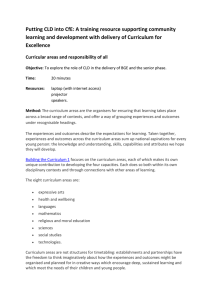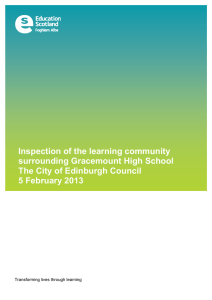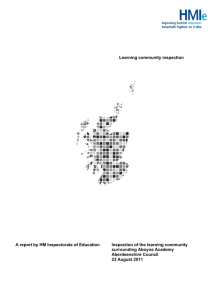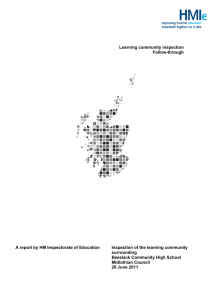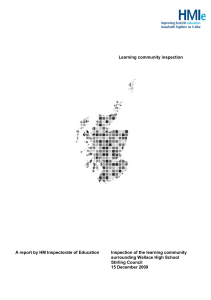Learning community inspection A report by HM Inspectorate of Education
advertisement
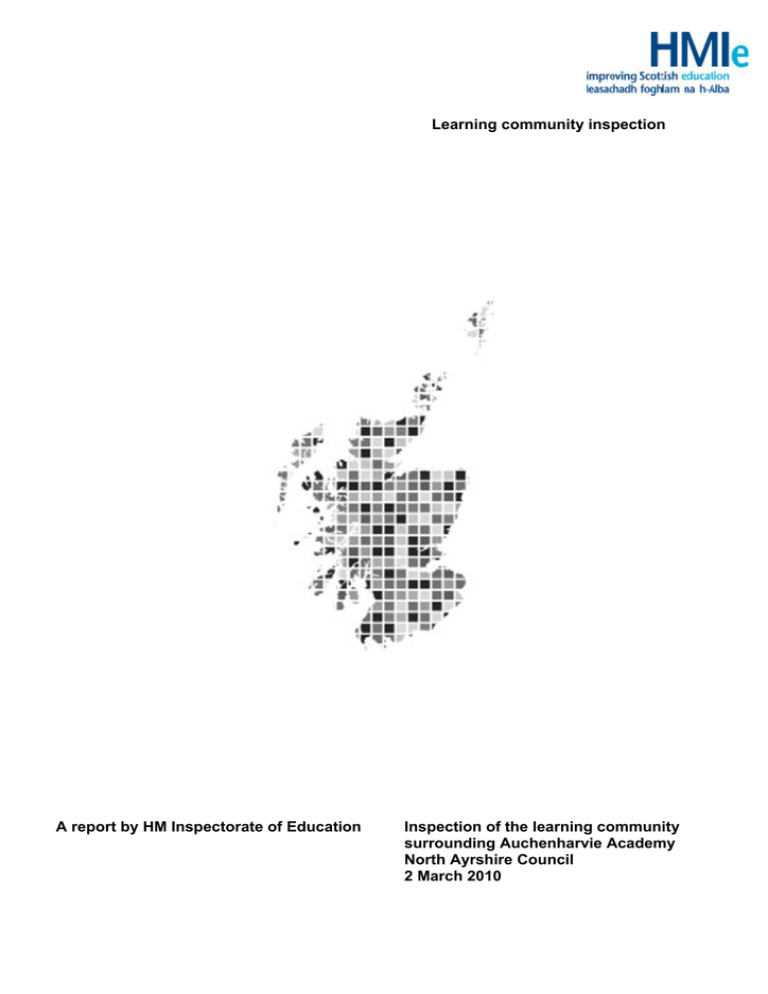
Learning community inspection A report by HM Inspectorate of Education Inspection of the learning community surrounding Auchenharvie Academy North Ayrshire Council 2 March 2010 We inspect learning communities in order to let those who use services and the local community know whether learning communities provide appropriate learning opportunities and help learners in their development. We are also interested in how community and voluntary groups are helped to contribute to making communities better places to live and work. At the end of inspections, we agree ways in which staff and volunteers can improve the quality of learning for young people and adults and how the impact of community and voluntary groups can be further developed. At the beginning of the inspection, we ask managers and staff about the strengths of the learning community, what needs to improve, and how they know. We use the information they give us to help us plan what we are going to look at. During the inspection, we join other activities which young people, adults and community groups are involved in. We also gather the views of learners, active community members and staff. We find their views very helpful and use them together with the other information we have collected to arrive at our view of the quality of provision locally. This report tells you what we found during the inspection and the quality of learning and development provided. We describe how well learners are doing and how good the learning community is at helping them to learn. We comment on how well staff, learners and groups work together and the difference they are making in the learning community. Finally, we focus on how well the learning community is led and how leaders help the learning community achieve its aims. If you would like to learn more about our inspection of the learning community, please visit www.hmie.gov.uk. Where applicable, you will also be able to find descriptions of good practice in the learning community and, in many instances, a report on the secondary school closest to the learning community. Contents 1. The learning community 2. Particular strengths of the learning community 3. How well do participants learn and achieve? 4. How well are communities developing and achieving? 5. How effective are providers in improving the quality of services? 6. Does the learning community have a clear sense of direction? 7. What happens next? 1. The learning community The learning community around Auchenharvie Academy includes the towns of Stevenston and Saltcoats (South). There are a number of significant challenges in terms of multiple deprivation, unemployment and poor health. The proportion of jobless people of working age population at 20% is considerably higher than the Scottish average of 12% and higher than the rest of North Ayrshire. The percentage of the population who are income deprived is 31% compared to the national average of 17%. The proportion of working age claimants on incapacity benefit at 10.9% is higher than the Scottish average and higher than the rest of North Ayrshire. 2. Particular strengths of the learning community • • • • Well-targeted and inclusive provision. Responsive and effective local partnerships. Effective community groups. Embedded culture of self-evaluation across community learning partners. 3. How well do participants learn and achieve? The quality and range of learning programmes is very good. Programmes are planned and developed in response to locally identified need. The number of adults participating in Community Learning and Development (CLD) adult learning opportunities has consistently increased over the last three years. A high proportion of learners are unemployed or in receipt of benefits. The retention of learners has also improved. A comprehensive range of accreditation awards are effectively used to record young people’s achievement. Annual accreditation targets have been exceeded. Targets in place for third sector organisations are used to measure the impact of their work and to inform future planning. An effective electronic management information system provides CLD service managers and staff with up to date information. This is informing decision making and improving performance reporting. Community Learning partners’ performance is regularly reported to elected representatives based on agreed strategic priorities. Expanding the range of agencies accessing the electronic data system would improve planning and service delivery. Young people There is an excellent range of quality learning opportunities available for young people. Community learning partners effectively engage with harder to reach young people. Youth work partners share a common belief in supporting young people to succeed and achieve. Young people benefit from highly effective joined up working between youth work projects. CLD youth service staff make very good 1 use of a wide range of accreditation awards across all groups. A vibrant Duke of Edinburgh Open Award unit supports young people to successfully complete and progress through awards. Young people take responsibility wherever possible. Young people within the Caley Centre are actively engaged as multimedia facilitators. Young Scot representatives support and maintain youth information within Auchenharvie Academy. There is a strong educational focus within youth work programmes. Targeted provision such as the Saltcoats Young Mums group is building their confidence and self esteem and successfully addressing issues such as isolation. As a result, participants have improved relationships with their children. Youth work apprentices successfully engage more disadvantaged groups such as Black and Minority Ethnic (BME), looked after and accommodated young people (LAAC), young tenants and disabled young people. As a result, a broader range of young people now participate in the authority wide youth council forum. A young tenants forum has been established. Projects such as the Caley Centre offers young people quality learning opportunities within an attractive learning environment. CLD youth service staff make a highly effective contribution to young people’s learning within Auchenharvie Academy. There are excellent examples of young people progression to volunteering, college provision and taking on leadership roles. Accreditation opportunities for Caley Centre multimedia learners could be expanded. Adults Partners work very well together to make effective use of community resources and to provide an excellent range of inclusive and accessible learning opportunities. Staff in primary schools and libraries make a significant contribution to community learning, bringing imagination and energy to the role. Targeted provision and very good referral networks are helping many vulnerable and isolated people engage in learning. These include ex-offenders, adults with learning difficulties, unemployed people, and people from minority and ethnic groups. There are excellent examples of impact on learners. Previous participants in the Police Standard Entrance Test preparation course have successfully gained employment as Police Constables. Learners are highly enthusiastic, motivated, and ambitious and many show great determination in pursuing their learning goals. Learners are progressing and achieving well. Ninety eight percent of all learners report that they had learned new skills. Ninety six percent of literacies learners had improved skills and knowledge. Tutors and volunteers ensure that learners help decide the content and style of many learning programmes. As a result, learners are able to quickly apply new skills and knowledge to their everyday lives. They are clear about the positive benefits to their social, emotional or physical well-being. The community learning partnership provides good routes for progression. There are formally accredited courses for learners of Gaelic, computer skills, and English for speakers of other languages (ESOL). The majority of learners are involved in agreeing and reviewing group learning goals. 2 4. How well are communities developing and achieving? Community organisations and groups are very active and influential. Volunteers and workers are highly skilled and confident. Individuals have progressed from being users of services to become volunteers and paid workers. Community groups value the support from CLD providers. They are equal partners when working with council services. All partners provide a range of effective, targeted services and programmes which benefit the community. As a result of advice from Community Led Action Support Projects (CLASPS) the number of people awarded benefit entitlements has increased. Skills Development Scotland provides effective job advice and support. Programmes and activities are jointly planned between organisations. Effective partnership working ensures people in the community are quickly referred to the appropriate agency. The North Saltcoats Neighbourhood Compact have been successful in securing improvements in street lighting and security. The Access Forum works well with local businesses to make improvements for people with disabilities. Community members are actively engaged in promoting issues such as older adult rights, the role of carers and disability issues at a national level. Three Towns Motor Project (3TFM) community radio working with CLD service staff is successfully raising health awareness to a wide audience and supporting local people to engage in volunteering. Generational barriers between different age groups are also being broken down. Engagement and consultation processes are in place for work with communities. Youth consultations are influential in securing improvements and opportunities for young people. Good progress has been made in implementing the Hayocks action plan. A more consistent level of capacity building support to local communities and networks would be beneficial. 5. How effective are providers in improving the quality of services? A regular programme of joint planning and evaluation has been established within Educational Services. There is a strong and embedded culture of systematic self-evaluation across the CLD service. Staff use a range of effective approaches to ensure continuous improvement. Community learning partners systematically gather the views of participants and use these to improve future activities. Staff regularly reflect on their own practice. The CLD service has developed an effective Performance Information Evaluation System (PIES) which helps staff monitor and evaluate outcomes across the learning community. This system has also been used very effectively to record the attainment and achievements of young people in Auchenharvie Academy. A range of education partners contribute to robust local learning community reviews. As a result of shared reflective practice partners now have a clearer idea of the impact they have on learning. A broad range of partners including voluntary sector organisations participate in the systematic planning and evaluation of the local Neighbourhood Compact. The annual community representative forum engages stakeholders from the local community in planning and evaluating provision. CLD service staff and local authority partners such as libraries are actively engaged in improvement planning at both individual and service level. The annual CLD standards and quality reports is informative and well presented. 3 6. Does the learning community have a clear sense of direction? Community learning partners share a clear sense of purpose and direction. Service management offer clear vision and leadership. Strong and effective partnerships operate across the learning community. There are very good examples of joint planning, self-evaluation and local partnership working involving the CLD service, libraries, arts and culture service, social services and schools. Integrated working by youth work staff in Auchenharvie Academy is highly effective. Creative internal partnerships involving the Caley Centre, and 3TFM are directly benefiting learners. Networking with local uniformed and community organisations could be strengthened to further support learning. 7. What happens next? The inspection team was able to rely on the high quality self-evaluation provided in the learning community. As a result, inspectors were able to change their focus during the inspection to support further improvements within the learning community. CLD providers have a good understanding of their strengths and areas for improvement and communities are achieving very well. As a result we have ended the inspection process at this stage. We have agreed the following areas for improvement with the education authority and its partners. • • Improve networking with local community based youth organisations. Ensure a more consistent level of capacity building support to local communities and networks. Quality indicators help CLD providers and inspectors to judge what is good and what needs to be improved in the work of the school. You can find these quality indicators in the HMIE publication “How good is our community learning and development? 2”. HMIE checks five important quality indicators to keep track of how well all Scottish CLD provision is doing. Here are the results for the learning community surrounding Auchenharvie Academy. Improvements in performance Impact on young people Impact on adults Impact of capacity building on communities Improving services Managing Inspector: Stewart Maxwell 2 March 2010 4 very good excellent excellent very good excellent This report uses the following word scale to make clear judgements made by inspectors. excellent very good good satisfactory weak unsatisfactory outstanding, sector leading major strengths important strengths with some areas for improvement strengths just outweigh weaknesses important weaknesses major weaknesses If you would like to find out more about our inspections or get an electronic copy of this report, please go to www.hmie.gov.uk. Please contact us if you want to know how to get the report in a different format, for example, in a translation, or if you wish to comment about any aspect of our inspections. You can contact us at HMIEenquiries@hmie.gsi.gov.uk or write to us at BMCT, HM Inspectorate of Education, Denholm House, Almondvale Business Park, Almondvale Way, Livingston EH54 6GA. Text phone users can contact us on 01506 600 236. This is a service for deaf users. Please do not use this number for voice calls as the line will not connect you to a member of staff. You can find our complaints procedure on our website www.hmie.gov.uk or alternatively you can contact our Complaints Manager, at the address above or by telephoning 01506 600259. Crown Copyright 2010 HM Inspectorate of Education

